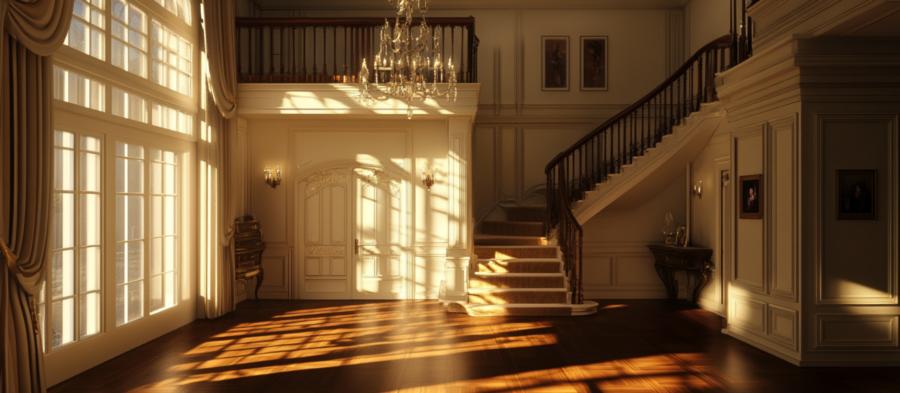Shadows: The Silent Sculptors of Space
Most people think of shadows as the absence of light, but that’s like calling silence the absence of sound. It’s technically true, but it misses the point. Shadows define objects, carve depth into space, and give rooms a sense of scale. If you’ve ever seen a room flooded with perfectly even light, you know it feels… wrong. A little unsettling. Like stepping into a sci-fi movie where nothing has texture.The secret lies in contrast. When light and shadow work together, they create a sense of form and movement, guiding the eye through a space. Consider a dimly lit restaurant—shadows don’t just make it romantic, they make it functional. By keeping some areas darker, designers focus attention on tables and intimate conversation spots, while the rest of the space fades into comfortable obscurity. No one needs to see every detail of the guy at the next table chewing loudly on his steak.
Mood Lighting? More Like Mood Shadowing
Ever noticed how horror movies and cozy cafés both rely on shadows, yet produce completely different emotional effects? It all comes down to placement and intensity. Large, undefined shadows create a sense of mystery and unease—your brain assumes something could be lurking there (possibly something unfriendly). Meanwhile, softer, more deliberate shadows can make a space feel inviting, like a warm blanket for your eyes.Designers manipulate shadows to influence emotions. Think of candlelight flickering on a textured wall. The shadows move, shift, and create an ever-changing pattern that feels organic and soothing. It’s the same reason daylight filtering through tree branches is more pleasing than staring at a fluorescent bulb. The dance of light and shadow mimics the way we see the world naturally, and our brains respond by relaxing.
Functionality: When Shadows Get Practical
Shadows don’t just sit around setting moods—they have jobs to do. In architectural design, shadows help regulate temperature by reducing heat gain in buildings. Smart shading can cut down on energy costs, proving that sometimes darkness is the real MVP.Then there’s safety. Too many shadows in the wrong places can turn a simple staircase into an obstacle course for the unsuspecting. On the flip side, a complete lack of shadows—like in an over-lit office—can cause eye strain and fatigue. Your brain expects some contrast. Strip that away, and it has to work overtime to make sense of the world, leaving you mentally drained and wondering why you suddenly feel like a husk of a human being.
Even in entertainment, shadows pull their weight. Theaters, for example, use controlled darkness to ensure audiences focus on the stage or screen. Imagine watching a play with bright overhead lighting illuminating the entire audience—it would feel less like immersive storytelling and more like waiting for your number to be called at the DMV.
The Art of Shadow Placement
Strategic shadow placement isn’t just an accident of lighting—it’s an art form. Architects and interior designers know that where a shadow falls is just as important as where light shines. Take accent lighting: when placed above an object, it casts a downward shadow that emphasizes its shape. When placed below, it creates an eerie, unnatural effect—great for Halloween decorations, but maybe not ideal for your living room.Wall sconces, for example, aren’t just there to add light; they create pools of illumination that contrast with surrounding dimness, giving walls more visual interest. Similarly, recessed lighting can make a ceiling appear higher by drawing attention to bright areas while leaving the corners in soft shadow. This technique is particularly useful in smaller spaces where you want to create a sense of openness without knocking down a wall.
And let’s not forget nature—the original lighting designer. Dappled shadows from trees, shifting with the wind, create a dynamic, ever-changing atmosphere that artificial lighting still struggles to replicate. The interplay of natural and artificial shadows is why some of the most beautifully designed homes take advantage of both, letting sunlight filter in during the day while strategically placed lamps continue the effect at night.
A World Without Shadows? No Thanks.
Imagine a world without shadows. Every object would appear unnervingly flat, like an old-school cartoon where everything seems stuck to the background. Faces would look strange, stripped of the natural contours that shadows provide. Photographers know this well—flat lighting makes people look washed out, while carefully placed shadows add drama and definition. That’s why beauty lighting isn’t just about brightness; it’s about balance.Even our perception of time depends on shadows. Before clocks, sundials relied on the movement of shadows to track hours. Without them, ancient civilizations would have had a much harder time figuring out when to start happy hour.
Throwing Shade (In a Good Way)
So, next time you marvel at a beautifully lit room, take a moment to appreciate the shadows doing their quiet, essential work. Without them, lighting design would be a one-note performance, lacking depth, emotion, and practicality.Shadows aren’t just the absence of light—they’re the unsung heroes of lighting design, shaping how we see, feel, and move through spaces. And while they may not demand attention, they certainly deserve a little more of it.
Article kindly provided by edslighting.co.uk

